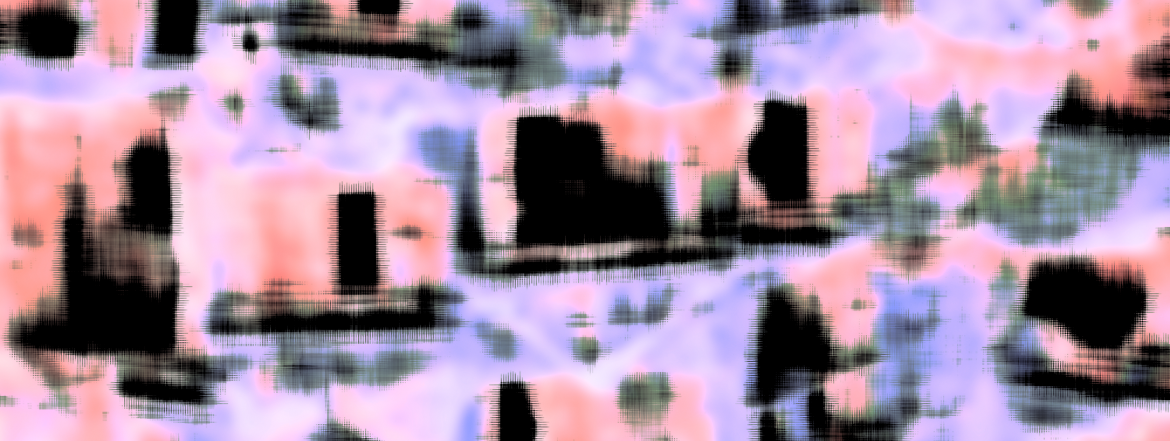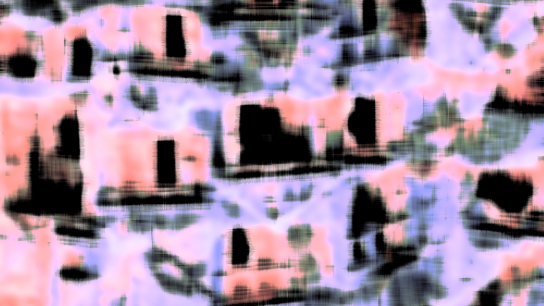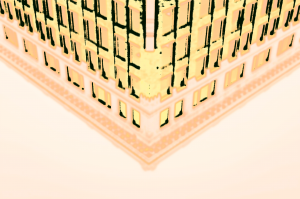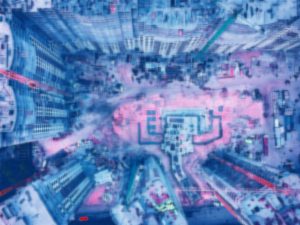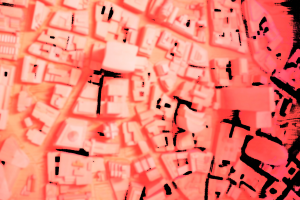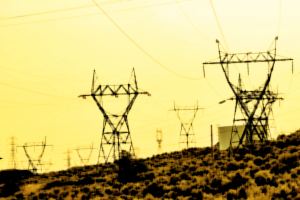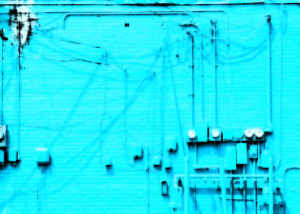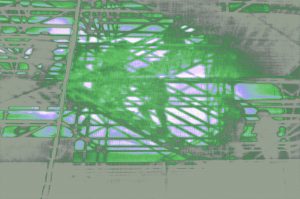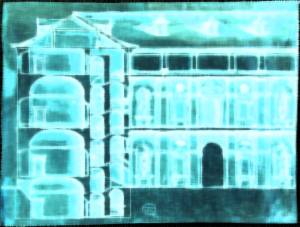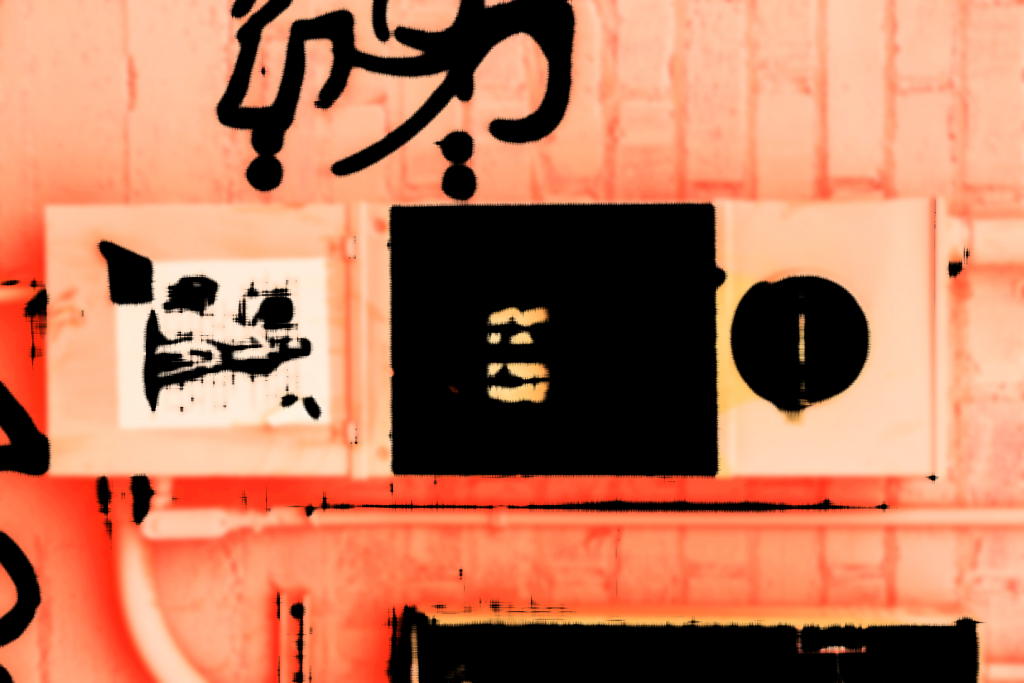Reading for Infrastructure
by
How is the air where you are?
I heard it was…?
Where are the biggest fires?
I wonder what they will do.
Did you see the pictures of the sky?
I wonder if it will rain.
Can you stay indoors?
How is your family?
How are you?
Our seminar began with California’s red, smoke-choked skies, Lauren Berlant’s “The Commons: Infrastructures for troubling times,” and the question, “what might it mean to read for infrastructure?” Although we were thinking about and with anthropological work on material infrastructures, most of us were not anthropologists. We took up infrastructure as method rather than object, observing how infrastructural perspectives worm their way into new disciplinary terrains, the places where its metaphoricity and materiality do unexpected theoretical work. We challenged each other to reimagine infrastructure as an interpretive method of analysis. How could we use infrastructure as a tool for reading the relations of race, labor and the environment, our three overlapping zones of critical interest. Our discussions sometimes became self-reflexive, given the online conditions of our seminar, in the midst of pandemic, uprising, and fire.
One recurrent thread in our discussions was that how we read infrastructure depends on what we think it does. Brian Larkin – in an oft-cited phrase – has written that infrastructure is “matter that enables the movement of other matter.” But that only describes certain kinds of infrastructure: railroad tracks or water pipes, for example. If the infrastructure in question is constituted by ships, ports, pipes or logistics then it is indeed a theory-metaphor for thinking circulation (Cowen). But if we are talking about oil rigs or mining equipment one might instead start thinking about how they enable forms of extraction. We need to think infrastructure’s transitivity (per our guest Jennifer Wenzel) in more expansive terms. So if the infrastructure is an aquifer (Ballesteros) or a grain silo, one thinks about holding or supply functions; if it is radioactive storage one thinks containment; if it is a wall one thinks separation; if infrastructure is bodies used to store lead (Graeter) it becomes about a form of incorporation; if it is waste disposal in Senegal one thinks labor (Fredericks); if it is a bunker (Duffield) one thinks securitization; if it is phatic labour (Elyachar) one thinks informal channels of communication; if infrastructure is a street (Abdou Maliq Simone), one might think about intersection and switching mechanisms, if it is landmines (Kim) or chemicals (Murphy), one might think latency, temporality and the agential qualities of matter.
Keywords
Breathfrastructure • Critical Infrastructure • Ecology • Energy • Entanglement • Chokehold • Maintenancer •Exhaustion • Chronic
Breathfrastructure (Adriana Johnson)
as everyone with lungs breathes the space between the hands and the space around the hands and the space of the room and the space of the building that surrounds the room and the space of the neighborhoods nearby and the space of the cities in and out. . .
—Juliana Saphr,
This Connection of Everyone with Lungs (2005)
Breathing in Saphr’s poem becomes an example of infrastructure for Lauren Berlant: that which sustains or holds up or organizes the common forms of life. One of the functions of the rhetoric of infrastructure is to refigure what “common” might mean: not likeness, equality, sovereignty, plenitude, surplus, nor the promise of a rich life. Rather than undifferentiated belonging there is instead a specific, precise patterning of proximity, connection, relation and distance. Breathing is one figuration of a bare, cascading connectivity, a minimal shared denominator-practice that sustains a scaling upwards but where distance is never collapsed between the various points in play since there is always space between. But breath is the starting point here and here: while it mediates, holds, spaces, and carries, it is not itself mediated.
This scenario breaks apart in times of Covid where police violence, viral sickness and smoke-thickened air intersect under the declarative “I can’t breathe.” Breath is apprehended as fraught, unevenly distributed, uncommon. And rather than a generic starting point, to want to breathe freely can become the banner for autonomy and separation: rather than connection it figures disconnection, a skin or surface that refuses to be refigured by a common articulation through masks. Take off the mask, they say, and feel the scent of love as if love, freedom, hate were what lay beneath, underwriting forms of life. Still, even the donkey will wear a gas mask in times of war.
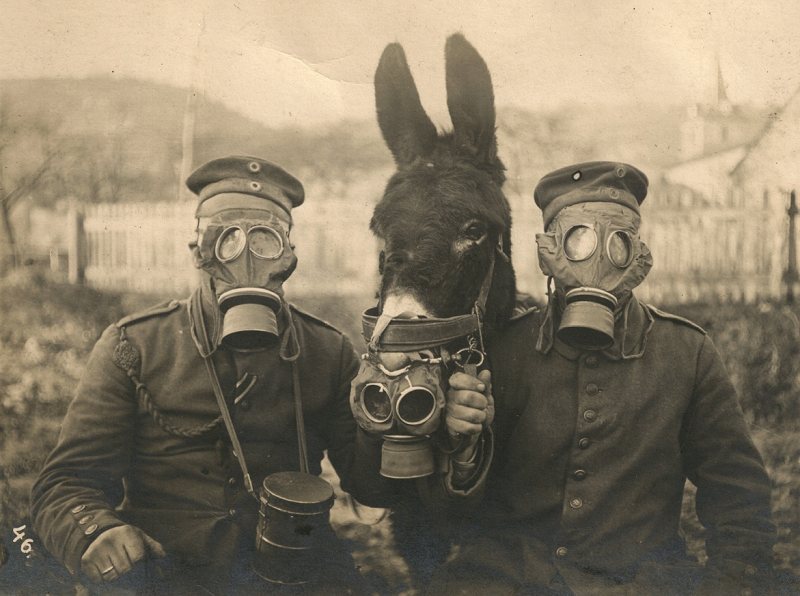
It is not just as if the composition of our surrounds had suddenly shifted, become liquid ocean, become airless space, requiring the multiplication of mediations already familiar to an astronaut or deep-sea diver: not only trachea, diaphragm, lungs, throat, muscle, nostrils, mouth but also masks, hoses or oxygen tanks. And it is not just that the virus has seemingly hijacked our air, like poisoned gas, turning it into a transport system for something other than oxygen. In this juncture we become aware that for a long time we have been – as Bruno Latour said – on life support. Breathfrastructure. The sudden awareness of the absence of that life support is a “feeling” rather than a seeing: “At first we feel nothing, we are insensitive, we are naturalized. And then suddenly we feel not something, but the absence of something we did not know before could possibly be lacking.” This feeling is more “roundabout” than seeing, something behind our back that we don’t exactly understand. It is out of sight but we cannot be outside of it. We cannot not be subjects of air. But breathfrastructure is not air, is not even the circulation of air, all of it entering in and out, but rather the purposed distribution and cultivated constriction of air: the design of green corridors to function like lungs for a certain part of the city even as comorbidities accumulate in actual lungs elsewhere over years of bad air. Or, in the short term, knees to the neck. ↵
Critical Infrastructure (Janet Walker)
Author’s note: This “critical infrastructure” keyword entry was brainstormed with Javier Arbona, whom I thank profusely for his brilliant and inspiring insights, evocative language, and informed points.
What is critical infrastructure? How do would-be infrastructures get nominated as such, by whom, and under what historical and political conditions? Infrastructural relations can and often are produced by policing and other institutional mechanisms of control (Arbona). For example, just days after his inauguration, Donald J. Trump signed Executive Order 13766 to expedite environmental review and approval of “high priority infrastructure projects.” He took aim at the “burden of regulation” and pumped up energy pipeline projects in the names of jobs and national security (Federal Register). Doubling down during the pandemic, in April of 2020, following the closure of two dozen meat-processing plants after clusters of employees tested positive for COVID-19, Trump issued Executive Order 13917 applying the Defense Production Act of 1950 to “food supply chain resources during the national emergency caused by the outbreak of COVID-19.” In the words of the order itself, “Such closures threaten the continued functioning of that national meat and poultry supply chain, undermining critical infrastructure during the national emergency” (emphasis added). The Order doesn’t say anything about vegetable growing or the individual and planetary health benefits of a plant-based diet.
From a humanities-based “Reading for Infrastructure” perspective, this deployment of critical infrastructure – the term, its material existence, its ideological charge, and its spatial imaginary – is as telling as it is performative. Oil, gas, and meat; deregulation and securitization; the supply chain as sacrosanct; the pipeline as promise. Here we have a president’s instrumentalization for “political effect” of the “deeply affectual relation people have to infrastructure”. And, given the combined impact of fossil fuel and factory meat production on particular human and more-than-human communities, as well as on average global temperature, the social ecology of the felt effects is unjust.
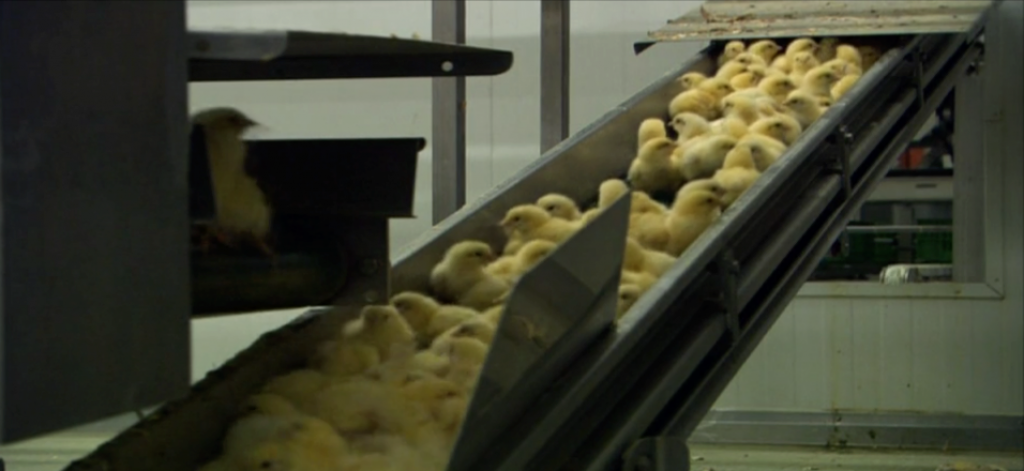
Being designated an “essential worker” in a critical infrastructure can help a person keep her job, pay the rent, and put food on the table. In some quarters essential workers have very literally been applauded by fellow community members. Yet the designation has also put people in harm’s way. Poultry workers, many of whom are Black and Latinx move in and out of factories that have been only rapidly and often incompletely reconfigured to address the transmissibility of the novel coronavirus. At the Mountaire Corporation poultry processing plant in Delaware, owned by Trump donor Ronald Cameron, workers wages have fallen as profits have risen, organized anti-union groups seek to undermine union representation, and OSHA and NLRB provisions have been suspended. Workers do or don’t contract COVID-19, do or don’t leave their jobs to save their and their families’ health, do or don’t get denied unemployment benefits—an action with which “essential workers” are being threatened. We could even discuss infrastructure’s vampiristic capacity to capture workers’ life blood (Arbona). Or, take the paths of chickens, cooped up and ready for slaughter on farms across the country. Millions of chickens have been euthanized where the “supply chain” has broken. But what does that mean since their fates were already sealed?
The notion of critical or essential infrastructure is sociopolitically, socioculturally—and sometimes sociopathically—constituted, sited, and enacted in specific historical contexts. As Trump issues his orders and memoranda, there is a pressing need to think and act from within or in solidarity with communities where people are resisting the toxic, supplanting, and entrenched violence of infrastructural assumptions and edicts. Whatever happens in the upcoming U.S. election, it is time to get critical of “critical infrastructure.” ↵
Ecology (Kathleen Frederickson)
Infrastructure is closely allied with the term “ecology”. Universities offer programs in “infrastructure ecology” that aim to build complex and adaptive networks, while green organizations promote “ecological infrastructure” as a “nature-based equivalent of built or hard infrastructure” that “deliver valuable services to people, such as fresh water, climate regulation, soil formation and disaster risk reduction.” These conjunctions are less surprising when we remember that, as concepts, they overlap. Brian Larkin’s oft-cited claim that infrastructures are “matter that enable the movement of other matter” could, after all, also apply to an ecosystem, in which soil, air, and water enable the growth of plants and animals. That said, ecosystems include the “other matter” that moves in a way that infrastructure generally doesn’t: “infrastructure” needs to be “for” something (capital accumulation, military deployment, or human life, for instance), while an ecosystem references a delicate arrangement of forms of matter and energy, in unequal and sometimes hostile configurations—the lynx and the hare, for instance, may both benefit from a local stream in their shared ecosystem, but the lynx preys upon the hare. In spite of these differences, ecologies turn into infrastructure, and vice versa. Writing about the landmines in the Demilitarized Zone along the border of North and South Korea, Eleana J. Kim follows Ashley Carse in understanding infrastructure as capable of producing environments; for Kim, the presence of the mines has led the area to DMZ to be rebranded as an ecopark, as though the absence of human development has allowed the area to become wild. Conversely, the “oystertecture” project in New York Harbor imagines regenerating depleted oyster populations as a kind of living breakwater such that, in Stephanie Wakefield’s words, they have become “refashioned and reimagined as infrastructure.” But in becoming infrastructure, the oysters also make and contribute to an oceanic ecosystem.
The efforts to model infrastructure as ecology seek to naturalize infrastructure and to highlight it as a constituent element in human life, even though examples abound in which the two appear at odds. Infrastructures can, of course, be made out of almost anything—organic and inorganic substances, living and non-living matter—and can thus readily become its own kind of ecosystem; at the same time, infrastructure can be tasked with delivering water, plants, animals, and energy to human population centers in ways that produce ecological collapse. ↵
Energy (Kameron Sanzo)
As infrastructure, energy is both the medium of conveyance and the product that circulates. It hardens into matter and structures, drawing on transformations of labor, capital, and materials. Critical infrastructures supply energy as fuels, which generate the conditions of public health and security. Yet energy exceeds the limitations of the fuel sector by both securing and threatening it. As “radiant infrastructures” energy creates new zones of contact, movement, and disruption. For example, energy sector operators must manage the circulation and transformation of materials as fuel, and manage the protection of those infrastructures from cyberattack.
Thus, energy is both on the ground and “in the air.” We interact with the architectures of radiation when we communicate, work, play, or simply move through space. But ambient, rarefied energies signal back to the material structures that ground, produce, and dispatch them. It is a loop that arrives full circle when radiant infrastructures securitize critical energy infrastructures from cyberattack; yet, as a modality, it also generates new points of rupture as people experience radiant energies with various degrees of sensitivity, and are connected to critical material infrastructures with various degrees of access.
Energy is overdetermined. It is more than fuel and wireless architectures. It operates in the spaces between desire and matter, and therefore comes into being as theory and infrastructure through its aesthetics and functions. Even in its earliest classical usages as “energeia,” energy denoted a preference for dynamics and transformation. Energy thus underscores the relationalities, circulations, and movement of infrastructure: in the critical transportation of matter through pipes, and in the visceral exchanges that create a sense of “being in” versus “belonging to” a commons. ↵
Entanglement (Ameeth Vijay)
Thinking of infrastructure and circulation of breath as metaphors for each other poses certain problems when it comes to the epistemology of cities. Ross Adams writes, “By the nineteenth century, planners had fully reformulated the city as a ‘biological organism’, whose naturally ‘functional parts’ were enabled through strategies of infrastructural connectivity.” That is, the circulatory city emerges in the 19th century as a series of interrelated systems and infrastructures that can be optimized. Circulation is a bodily analogy here, in which the city is like a respiratory system. The analogy is extended to social relations and to the natural systems ‘underneath’ the built environment: all function as a harmonious, circulatory infrastructure and all could be harmonized together.
A current example of this epistemology might be found in the ongoing development of the Thames Estuary. The Estuary are classic “edgelands,” in Marion Shoard’s term, areas of in-between space here targeted for redevelopment because of their confusing liminality. They are ‘brownfield’ sites, spatial manifestations of pollution; parts of this corridor have the highest levels of air toxicity in the UK. To this state of affairs comes urban development and design, which proposes technological and infrastructural solutions to the problems of environmental and economic harm. Drifting between the literal and figurative, they promise to render the corridor into a green, sustainable, breathing lung for the city.
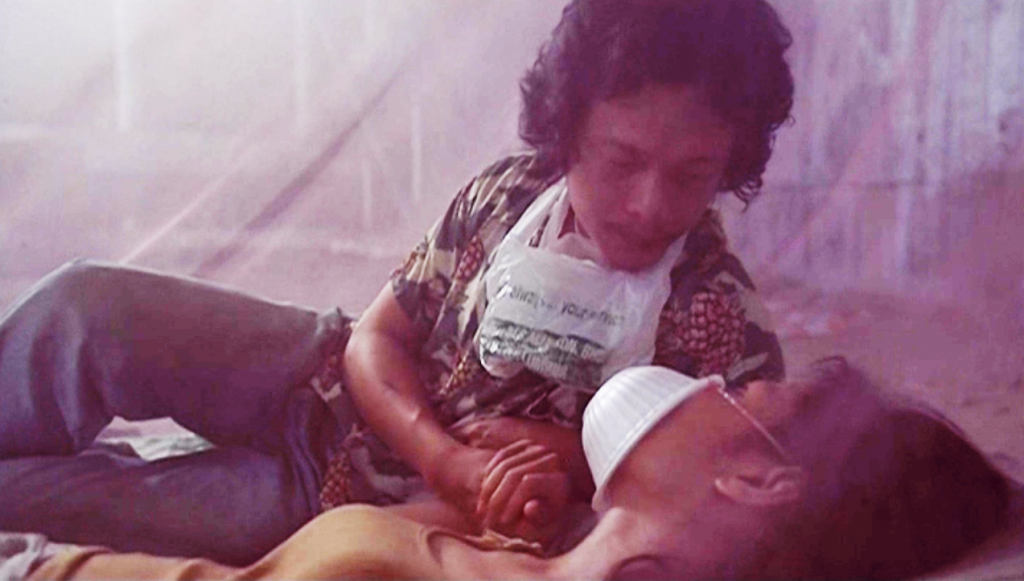 Still from Tsai Ming-Liang’s, I Don’t Want to Sleep Alone
Still from Tsai Ming-Liang’s, I Don’t Want to Sleep Alone
A different experience of sharing is registered in Tsai Ming-Liang’s 2006 film I don’t want to sleep alone. The film doesn’t have a plot but instead presents a scenario: transient individuals in Kuala Lumpur, caring for, sustaining, and holding up others who can’t breathe due to illness or injury. At one point, a toxic haze descends upon the city. We hear from a radio news broadcast that this is the result of fires. Two sources are blamed, both of which speak to patterns of relation and proximity: one, the neighboring country of Indonesia with its annual forest fires in Sumatra, and the other, the “illegal workers” who live in “makeshift houses” and burn their trash in the open, causing a more local urban fire. The PSI index is above 650, and masks are in short supply. We see people gathered together in cafes and congregating in front of a video store, some wearing masks and others not. “Masks,” in this case, are on a spectrum between handkerchief, plastic bag, and styrofoam bowl. Two characters that the film has been following wordlessly meet and go to an unfinished apartment tower where one of them has stayed while recovering from a brutal assault. They remove masks and some clothes, but their breathful intimacy is interrupted by fits of coughing. The scene is endearing and comic, as the two connect (through lungs, throat, muscle, nostrils, mouth) for moments before needing to cover their faces with their makeshift masks to help with the coughing. Eventually, they seem to give up, embrace, and fall asleep.
This description runs the risk of romanticizing precarity and informality, as scholars of the urban everyday have often done. Living is not the same as living well. The global film ‘circuit’ that delivers these scenes to me, in the global north, are a series of mediations beyond that of the film itself, serving as much to disconnect as to connect. While the film resonates with my experience of California in the summer of 2020, with its pandemic and social distancing and fires and suffocating politics, that resonance can drown out the politics that create incommensurable situations of precarity far beyond my experience. The fires may connect to an ambient infrastructure of breath, made visible as haze and unnaturally red suns and apocalyptically orange skies; visible or not, it is not commensurable with the breath of a firefighter who is also an inmate. The distance is never collapsed, and thus the entanglement is also what produces impasse.
Adorno, not (necessarily) speaking of fires, writes: “There is no way out of entanglement. The only responsible course is to deny oneself the ideological misuse of one’s own existence, and for the rest to conduct oneself in private as modestly, unobtrusively and unpretentiously as is required, no longer by good upbringing, but by the shame of still having air to breathe, in hell.” ↵
Chokehold (Sage Gerson)
Herman Gray, facilitator of UCHRI’s Race at Boiling Point: The Fire This Time, opens the conversation with “the incredible insights and the incredible language of ‘I can’t breathe.’” He links the phrase to the layered social, medical, and environmental violences enacted against Black and Brown people. He elaborates:
So I think about breath in terms of environment and polluted air and the environmental degradation that poor and Brown people have to live through. Breath and breathing as the terms to understand the devastating health impacts of the pandemic of COVID-19, which disproportionately attacks Black and Brown people — particularly around respiratory systems in urban populations and vulnerable populations. But it also expresses the constricted air available to Black men, women, and children at the hands of police through legal tactics such as chokeholds and knees to the neck.
“I can’t breathe” is not a singular event, but instead a pattern, a structure, a system of strangulations, stressors, and strains. Susan Leigh Star and Geoffrey Bowker posit that “the relational quality of infrastructure talks about that which is between.” Thinking air as infrastructure must, then, contend with that which comes between oxygen and the act of breathing in an effort to contain, control, and strangle. Breath may keep alive, but like all infrastructure, it is not universally experienced or evenly distributed. The life-sustaining circulation of breath for BIPOC individuals and communities has been repetitively choked by feet on necks, knees on necks, hands, arms, nooses circling necks, inhibited by uneven exposure and environmental racism, and blocked by COVID-19. These strangulations of possibility, these cultivated chokepoints called out through the refrain “I can’t breathe”, are also a pattern of relation and proximity, an infrastructure. Christina Sharpe writes of Black being “as the human insurance for…white circulation as the human.” Sharpe places “I can’t breathe” alongside the history of the spirometer, which marked Black lungs as “different” and “defective”. Sharpe asks, “Who has access to freedom? Who can breathe free? … What is the word for keeping and putting breath back in the body?”
Writing about COVID-19 in April 2020, Achille Mbembe metaphorizes injustice and inequality as “stranglehold” and “chokehold,” noting that, “wars on life begin by taking away breath.” Covid-19 impedes breathing and blocks the resuscitation of human bodies and tissues. Mbembe writes of the consequences of violence as the forced absence of breath. His attention to breath operates on multiple scales, the zoomed out global infrastructures of injustice (stranglehold) and inequality (chokehold) that exacerbate the spread and experience of COVID-19, and the zoomed in intimate, embodied, fleshy infrastructure of blood and tissue.
Alongside the other intimate and fleshy infrastructures that support the circulation of air throughout the body, the lungs — as Melody Jue writes — act as “an interface” with life-sustaining air. Inhaling brings the outside in, blurring the perceived boundary between human (insides) and (outside) air, atmospheres, and environments. Human respiration depends on photosynthesis; plant life’s planetary exchange of carbon dioxide with oxygen makes human life possible. Breath is co-constitutive and entangled — in the inhale, exhale, and dynamic exchange. Trachea, diaphragm, lungs, throat, muscle, nostrils, mouth, blood, tissue. Breath is exchange, circulation, absorption. Detroit-based poet Jamaal May writes in “Respiration,” that:
A lot of it lives in the trachea, you know.
But not so much that you won’t need more muscle:
the diaphragm, a fist clenching at the bottom.
Inhale. So many of us are breathless. (2016)
“Respiration” is part of the collection Poems of Anxiety and Uncertainty, which “confront[s] and cope[s] with uncharted terrains through poetry.” While the muscles of May’s poem clench, its speaker sighs and worries, anxiously asking “will you hold your breath”? ↵
Maintenancer (Roderic Crooks & Salvador Zárate)
Bridges, ethernet cables, Internet protocols, experts: the category of thing called infrastructure draws together an endless, perhaps infinite, variety of objects and subjects. Infrastructure names any pervasive set of resources in networked form: maintenance is the labor dedicated to guaranteeing such pervasiveness, the non-innocent, idiosyncratic practices of care that these complex networks demand. Whatever infrastructure might be, its only essential quality is that it demands to be maintained. Forms of life gain coherence from infrastructure, for the shape of the world given by artifacts. Likewise, maintenance keeps some things stable and simultaneously makes certain kinds of circulations impossible, unthinkable, unworkable. An interest in maintenance pulls focus from invisible things that order human life to the ubiquity of the labor that lends matter a recognizable and dependable existence. If infrastructure has any kind of invisibility, it is because someone’s job is to keep it out of sight.
The maintenancer is that (non)subject or invisible relation whose labor limns the very exhaustive and exhausting activity that might be said to uphold the everyday. In the world of boardgames, there is often a round of maintenance and upkeep, revealing the game’s seams and meta-labor necessary to sustain its fantasy. Sometimes it is the burden of a sole maintenancer, other times the burden falls on all the players. And after which– just like that– the fantasy is remade into a compelling whole.
What does it mean to tarry in the maintenance of our own made world? One that acknowledges the protracted condition that is the ongoing demand, extermination, and expropriation of particular bodies as the precondition of its naturalized (though unnatural) set-up. These are the conditions by which maintenancers are subjected to the upkeep; existence in a world in constant need of regime maintenance, as Cedric Robinson has termed it, as a way to reproduce its unnatural, anoriginal logic. Forging an array and arrangement of the world sprawled out in the form and service of the liberal humanist subject– of Man– and leaving behind the splayed, those produced as vulnerable difference on which its fictional coherence depends.
The maintenancer labors in the context of death-dealing fiction-making even as they forge distinct worlds – imperceptibly– with a heft of connections, desires, memories, and longings, emerging as excess unadapted forms by infrastructures necessary to sustaining liberal humanism. These doubly invisible relations of excess, made of appropriated and obscured labor, spill not to cover the cracks forming and requiring maintenance but as an invitation to a fugitive world underneath– impossible, unthinkable, unworkable. Infrastructural analysis in humanistic inquiry demands an exploration of the existence of maintenancers, a way of looking at those who must labor so that lives deemed human can keep their predictable dimensions. ↵
Exhaustion (Susan Zieger)
“Exhaustion” usually arises in relation to natural resources, which are proleptically figured as “supplies” or “stores” for human use. The dominant example of the conversation about fossil fuels thus fits oil into a Victorian paradigm of bourgeois accumulation and squander: once we exhaust our supply, we will be forced to find alternatives. During the Industrial Revolution, “exhaustion” was also a complaint of workers, who leveraged the Christian designation of Sunday as “a day of rest” against capital’s demands. Exhaustion today is difficult to separate from this lineage of defense of nature and humans against capital predation. And yet the term has not yet lined up with infrastructure, which is more often described as broken or in need of repair. Infrastructure is inanimate, but exhaustion is a property of living things. Yet, taking a cue from recent scholarship that considers people as infrastructure; their bloodstreams as performing the work of containing toxic waste; their bodies’ aesthetic and affective potential as a regenerative source of the commons, we can see that we ourselves are living infrastructure. We are part of discourses of ecology and energy. What would it mean, on this basis, to organize a new politics of protest against exhaustion? ↵
Chronic (Anirban Gupta-Nigam)
-
- As an amateur swimmer, part-time smoker, and professional asthmatic, I know something about the inability to breathe, and how sudden onsets of breathlessness differ from being a little unable to breathe all the time.
- Like infrastructure revealing its infrastructure-ness in breakdown, I am conscious of breath when it’s constricted.
- Like infrastructure revealing its infrastructure-ness in breakdown, lungs giving way are not an occasion for revelation. The fact of smooth operation doesn’t imply ignorance of the process.
- Unable to complete a deep breath for years, I was convinced my lungs were caving in. This wildly paranoid thought brought awareness of the body—mine?—as an apparatus. Of lungs as an interface mediating one’s experience of the world.
- When it’s not exchange, circulation, absorption, breath contains, controls, strangles.
- The inability to breathe freely affects a person’s capacity to touch, smell, and taste.
- It remains unclear what breathing freely amounts at this time, on this planet.
- To want to breathe freely can become the banner for autonomy and separation.
- Low-level anxiety is normalized. The body is always on the verge of breakdown.
- Atmospheres become stifling when the capacity to breathe normally is reduced.
- It remains unclear what normal breathing amounts to when toxic fumes and wasted geographies ensure lungs are always on the verge of failing.
- Learning to swim, initially I breathed in panic—afraid if my head didn’t bob sufficiently above water, I would drown. In time, adjusting to the mechanics of taking in air, I learned drowning is not as easy as it looks.
- Machines stop. Machines can be stopped.
- Breathing is chronic. You breathe to live even if it is a burden. You live to breathe because when lungs collapse, you realize something of the vitalism we have learned to dispense with in theory.
- Living is not the same as living well. No one lives well with the chronic; what Eric Cazdyn calls a logic of biopolitically managing time, deferring transformation to an unarrivant future.
- Between oxygen and the act of breathing, a system to partition air; adjudicate breathability.
- Suturing a respiratory disease and unequal distributions of environmental harm to the boots of the state, “I can’t breathe” indexes infrastructural cruelty. If the slow violence of industrialism doesn’t lay you to waste, comorbidities accumulated over years of bad air and terrible food will see you through to the end in the ICU. Failing which, there is always an officer around to turn off the machine. Planned obsolescence. In this way, the police are also an ecological catastrophe.
- Apprehended as fraught, unevenly distributed, uncommon, breath pressures celebrations of entanglement with otherness—human and nonhuman life. Entanglement also produces impasse.
- In July, Leanne Shapton wrote on Instagram that for swimmers, “I can’t breathe” is a call for help. First you acknowledge the call, then you respond.
- Sometimes people ask why swimmers and asthmatics smoke.
- Sometimes smoking is a way of taking control of infrastructure, of remaining calm in the face of existential dread, of accelerating your demise to ensure no one else has the last say.
- Swimming and smoking maintain bodily infrastructure; a balance between health and sickness, playfully internalizing the New Age Buddhist dictum: do everything, but in moderation.
- “… that cigarette/ Which glowed patiently through all your labours/ Nursing the one in your lung/ To such strength, it squeezed your strength to water/ And stopped you.” ↵
